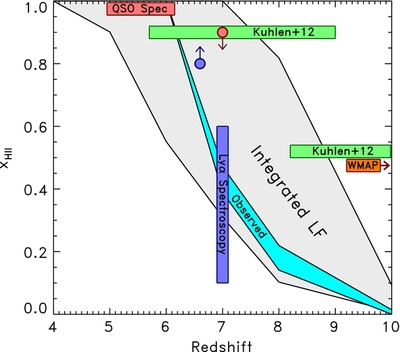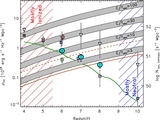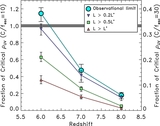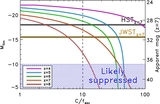Image Details

Caption: Figure 6.
Volume ionized fraction,
x
H ii, of the IGM which can be sustained given the observed UV luminosity densities (and our assumptions on C and
f
esc) as a function of redshift. We assume that galaxies are the only significant sources of ionizing photons in this epoch. The
cyan and gray curves denote the value of
x
H ii inferred from comparing our observed galaxies, and the integrated luminosity functions, respectively, to the critical luminosity
density from Equation (2). We have assumed
C/
f
esc = 10 when only considering the observable galaxies, and
C/
f
esc = 30 when considering the integrated luminosity functions (both of which are consistent with limits on
f
esc from the
z = 6 Lyα forest presented in Section 4.5, for
C = 3). We note that while the luminosity density from the integrated luminosity functions will always be larger than that
for galaxies above our observational limit, here the two different escape fractions for the two magnitude limits result in
their ionizing luminosity densities being comparable. We plot constraints on
x
H ii from spectroscopy of quasars at
z < 6 from Fan et al. (2006) and at
z = 7 from Bolton et al. (2011) in red. The blue circle denotes constraints on
x
H ii from the evolution in the Lyα luminosity function from
z = 5.7 to 6.6 from Ouchi et al. (2010), while the blue bar denotes the range of
x
H ii values inferred from the
z = 7 follow-up Lyα spectroscopic studies of Pentericci et al. (2011), Schenker et al. (2012), and Ono et al. (2012). The instantaneous
redshift for reionization from
WMAP (10.6 ± 1.2) is indicated by the orange rectangle. The derived 50% and 90%
x
H ii redshifts from the study of Kuhlen & Faucher-Giguère (2012) are shown in green, where the width of the green bars denote
the 1σ uncertainty (from Figure 9 of Kuhlen & Faucher-Giguère). Our observations, which are consistent with a wide range of
other, complementary, approaches, find a picture where the universe is fully ionized by
z = 6, with the neutral fraction becoming non-negligible at
z
![]() 7 for our assumptions regarding
C/
f
esc.
7 for our assumptions regarding
C/
f
esc.
Copyright and Terms & Conditions
© 2012. The American Astronomical Society. All rights reserved.









